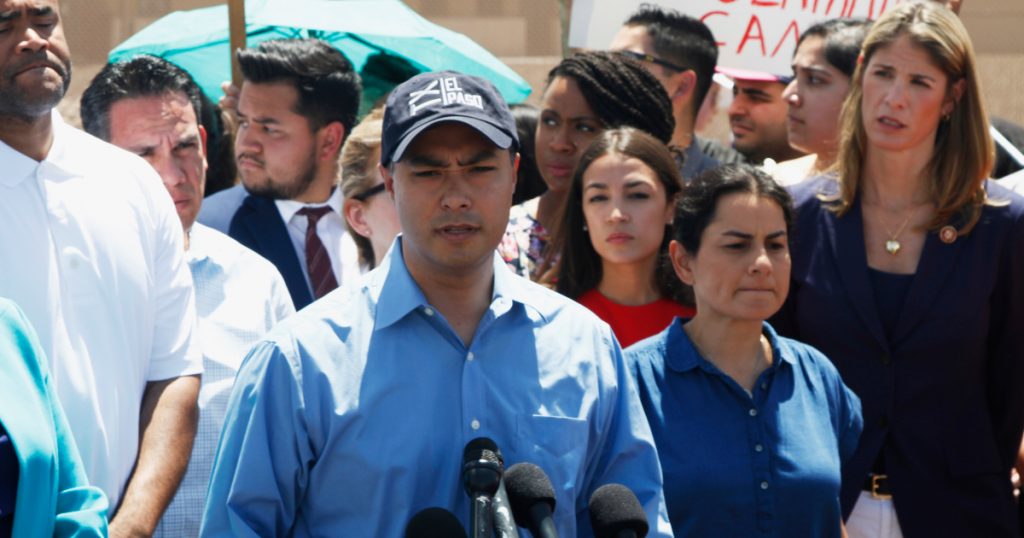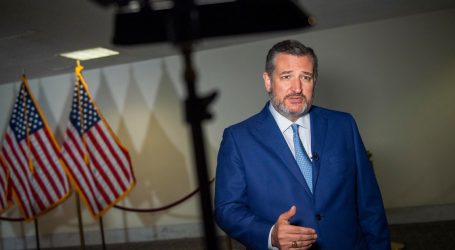Rep. Joaquin Castro Explains the Frustration—and Optimism—in Today’s Visit to a Migrant Detention Facility
Rep. Joaquin Castro (D-Texas) speaks alongside members of the Hispanic Caucus after touring inside of the Border Patrol station in Clint, Texas, in July 2019.Cedar Attanasio/AP
Let our journalists help you make sense of the noise: Subscribe to the Mother Jones Daily newsletter and get a recap of news that matters.On Friday morning, about 50 miles from the US-Mexico border, Rep. Joaquin Castro (D-Texas) lead a tour of the Carrizo Springs detention facility for unaccompanied migrant children, as the number of kids in US custody continues to rise. The facility is not a Border Patrol holding cell, facilities that have sparked outcry across the political spectrum for their dire conditions, but a place where migrant kids are taken after they’ve passed through border custody. Still, in the past, temporary influx shelters run by the Office of Refugee Resettlement, like Carrizo, have been roundly criticized as places where children should not be kept long term. So Castro, along with six other Democratic members of Congress from districts beyond the border, visited the shelter to ensure “the humane treatment” of the children being held there.
What they reported was not exactly great, but it was perhaps somewhat encouraging, particularly in light of other dire images of migrant families held at the border. In fact, some of the members of Congress who spoke at a press conference after the tour said they were optimistic to have the Biden administration in charge because they believed it would listen to their recommendations based on what they saw Friday. Rep. Barbara Lee (D-Calif.) said she specifically paid attention to the physical and mental health of the children at Carrizo Springs and she was “pleased to see and learn that these young people have crisis intervention and mental health services available to them.”
I caught up with Castro on the phone shortly after the presser, and began by asking him why he organized the tour and what he saw: “We went with the understanding that the best place for these children to be is not in a government facility, but in the homes of their American sponsors, as they await their court dates for asylum,” he told me. “These emergency shelters are better places for the children than the CBP processing centers, but they still need to be moved out as quickly as possible to be with family sponsors.”
What follows is our conversation, which has been lightly edited and condensed for clarity.
Did you speak directly with any of the kids held at Carrizo Springs? What story or interaction is sticking with you?
We had a sit down conversation with about a dozen of them, and then we had a chance to spontaneously interact with others. The ones that I interacted with seem to be kids that were between about 13 and 17, and from Honduras, Nicaragua, El Salvador, and Guatemala. We asked them what message they would send to the American people and to the president, and one of the young men said that they just wanted to be treated with dignity and that they were human beings. And I think that gets lost in the issue of the border sometimes when we debate it, and it rises as a controversy; we can forget about the basic humanity of these people who are fleeing very violent, dangerous situations.
In July of 2019, at a time when we had seen a record number of migrants at the border, you were part of another congressional delegation that toured border detention facilities in the El Paso area, which were described as broken and horrifying. Some held children, others held migrant women. You even took videos inside that facility that went viral. Looking back at that press conference after the tours, compared with today’s press conference, the tone sounds different. While you didn’t visit the same type of facility, what’s the biggest difference now?
You have an administration that is committed to solutions now. They obviously have a lot of catching up to do—most of all, because of how Donald Trump left the asylum system in the United States. He did as much as he could to dismantle the system for processing and settling asylees in the United States. I would say the big difference now is you have an administration that acknowledges there’s a problem and wants to fix it. Back then you had an administration that knew there was a problem and didn’t want to lift a finger to do anything about it and, in fact, I think inflicted pain upon these people as a political message.
What you saw at that time in 2019, that I captured on video, was one of the CBP processing centers where you had around 20 Cuban women who were staying in very cramped, unsanitary conditions. And as you can see from the photos at the CBP processing centers now, that’s still the case. So one of the things that we are proposing is to be able to process asylum seekers at places other than the CBP processing centers, because those are the most cramped, unsanitary, and I would argue dangerous places, especially for children.
This week we learned that migrant families, pregnant women, and little kids, are being detained by Border Patrol outdoors in holding pens under a bridge in the Rio Grande Valley. They were kept there for days, exposed to the elements and sleeping on dirt. Some were still wearing wet clothes from having crossed the river. Were you able to see that first hand? Do you plan to visit those holding pens?
Over the years, I’ve visited there many times, but I do plan on going back. I did want to go to Carrizo Springs first because this was the first “influx shelter” that was opened up. But I will go back to the CBP processing centers. And I think we should all be able to agree that those conditions are unacceptable. And even Joe Biden yesterday suggested as much in his press conference. And so what you see now is that Congress tried to work with the administration to remedy this. And that’s why we talked about this proposal to build a humane facility to be able to process people once they present for asylum at the border. Right now, they go to those CBP centers that are cramped, and unsanitary, and dangerous, and we should be doing it a different way.
Republicans and Democrats have visited the border recently and the American public is getting a different version of “reality” depending on the visitors’ party affiliation. The border and these migrants’ lives are becoming, once again, part of a political game. So if we can put politics aside, what can Congress do right now to address the issues you and I just talked about?
Congress should draft with the administration a Marshall Plan for Central America to make strong investments in Central America, in its economic prosperity, in the security of its people, in the rule of law, in rooting out corruption, so that Central Americans will have an opportunity to thrive and prosper and live safely in their home countries. Which is what I think they ultimately want. I don’t believe that most of these people, if they felt they had a real choice, a safe choice, would want to leave their homes and trek 1,000 dangerous miles to the United States. And also domestically, reforming the asylum process in the United States, which in the immediate term means building up the capacity to safely and humanely take care of unaccompanied minors and other asylum seekers until they can be placed with family sponsors while they await their asylum hearings.
Does this require more resources or a different way of spending those resources?
It’s a combination of both. I think we’ve got to take a serious look at how we spend our money. For example, of course, President Biden has halted border wall construction, but during the four years under President Trump, it was a grave mistake to be spending money on a border wall when we were confronting a lot of the challenges that Trump has left us with now.
A lot of what we’re seeing today is similar to previous years and previous “border crises” under different administrations. I still remember being shocked when I toured a Nogales warehouse where a thousand unaccompanied kids were held behind chain-linked fences in 2014. Then in 2019, we saw overpacked Border Patrol jails and people detained outdoors. The US government seems to continue to be unprepared for processing and detaining migrant families and children even though we’ve known for years and years that the demographics at the border are changing and it’s no longer just adult men. Why does that keep happening? Why are we here again?
I think there’s got to be a new approach to how we do these things and there has to be greater capacity than trying to bottleneck a bunch of people through the CBP processing centers, which is where you have the largest problem. You’re right, I mean, in 2014, we faced a lot of the same challenges. And it’s time that we swiftly move in a different direction. Starting with greater capacity to temporarily hold people, and then moving them more quickly and more efficiently into their family, with their family sponsors. You know, it’s going take you some amount of time to process everybody. In other words, somebody isn’t going to come to the border, and then literally 10 minutes later, they’re on their way to a family sponsor. But the question is how you treat them? And how do you handle them during the time that they are in government care? And that’s what this visit was about. That’s what a lot of the debate has been about. And we can do a much better job as a government, including getting rid of those chain-link fences, getting rid of those awful aluminum looking blankets—a lot of different things that this administration has an opportunity to work on in earnest.
Now that you and your colleagues have have done the tour today and you plan to visit other facilities, what kind of conversations are you going to have with leadership in the White House? And what do those look like?
I led this trip on behalf of the Congressional Hispanic Caucus, so I’ll go back and brief the [CHC], and work with not only the caucus, but other colleagues in Congress to press some recommendations. And the Biden administration is already aware of most of these recommendations. So they have been discussed because it’s a matter of actualizing these things; some of them are going to require more federal resources. But we want to make sure that we’re moving as quickly as possible to make these changes.
My recommendations would be: First, keep people in a place other than the border processing centers that we have now. So new processing centers. Second, mobilize the federal workforce around the border region, so that you’re able to coordinate quicker and move people through the system faster. The third recommendation is for the federal government to do a better job of accepting donations from the American people. I haven’t seen any kind of coordination or real effort to accept donations from the American people, although there’s a lot of goodwill out there towards these folks who are seeking asylum. I don’t understand why people are sleeping with these horrible aluminum looking blankets or don’t have a pillow to sleep with, so things like that don’t make any sense to me that you can’t accept donations—blankets, pillows, clothing, toothbrushes. I don’t get that; I don’t know if that’s a symptom of a bureaucracy or what that is, but to me, seems like an easy more immediate fix.





